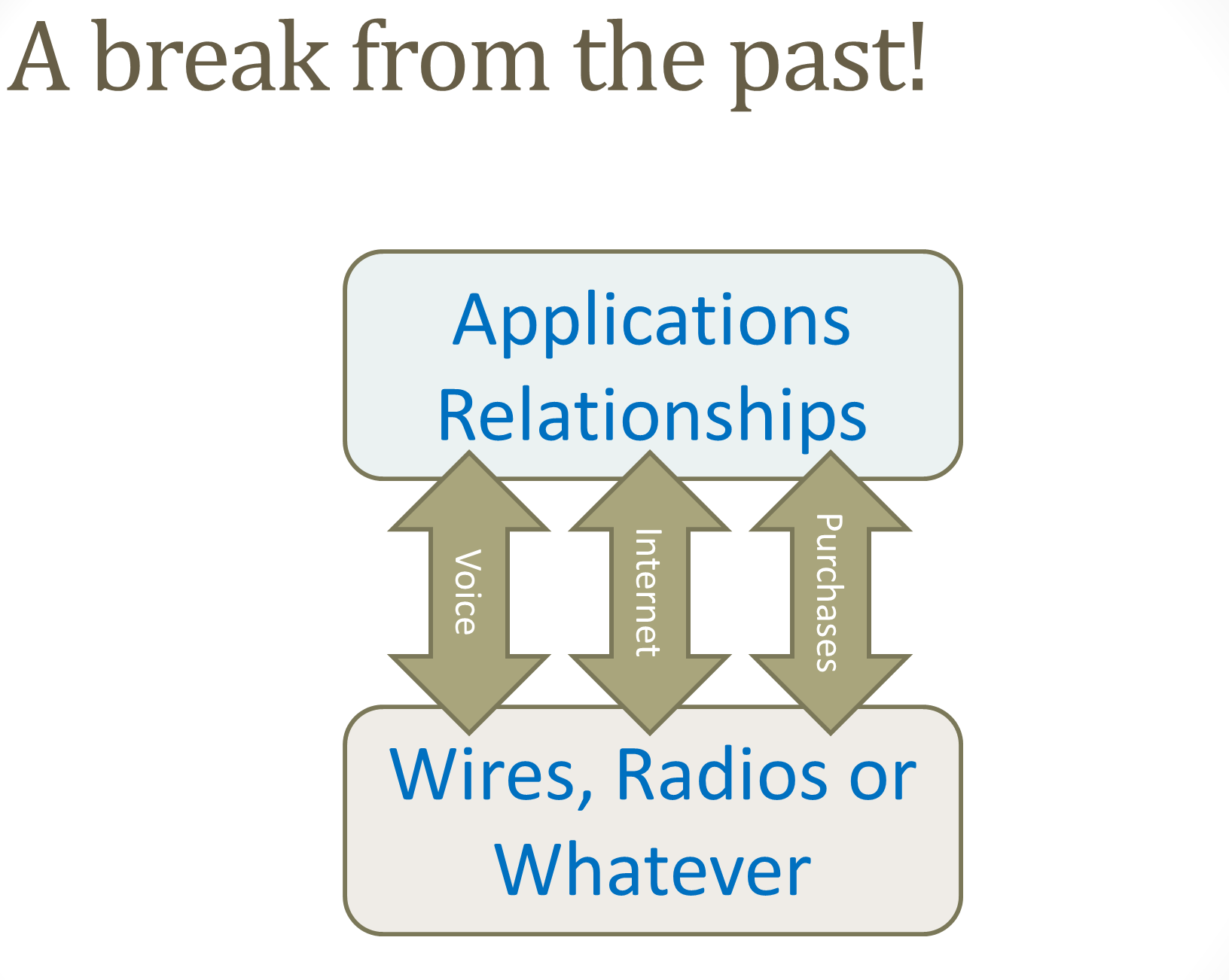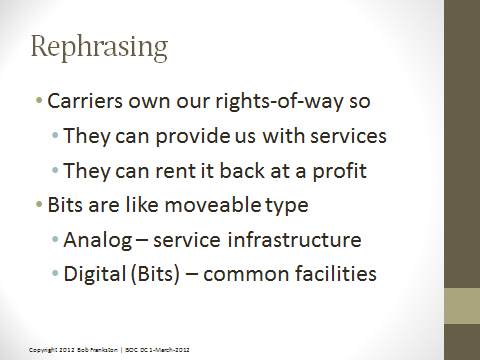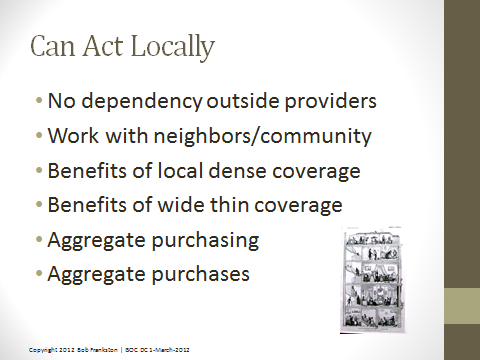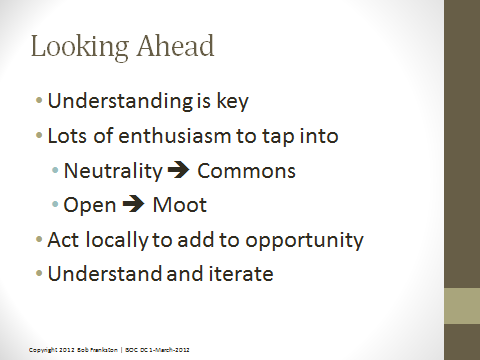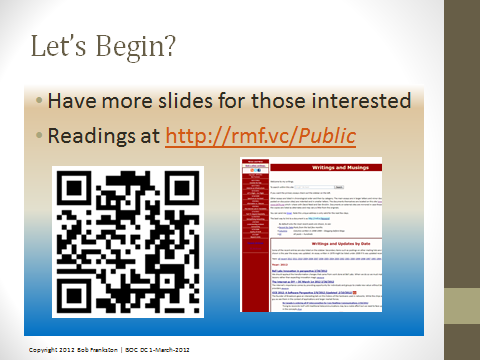Contents
- From DIY to the Internet
- Slide Commentary
- Do It Yourself – 1960’s / 1970’s.
- The Words we Use
- The World as your Oyster
- Railroads
- Telecommunications
- A Service per Device
- Stop the Presses! ATT’s at it again!
- A Break from the Past
- Rephrasing
- Any to Any but no Promises
- Can Act Locally
- Looking Ahead
- Let’s Begin
- Additional slides?
- Further Reading
 The talk I gave at ISOC in DC is available on YouTube.
The talk I gave at ISOC in DC is available on YouTube.
The first part is here (starting at 4:17) and then in parts 4, 5 and 6 of the video. You can watch all the parts as a playlist by following this link. You can click on each slide below to position yourself at that point in the video.
These comments complement rather than replace the video.
You can click on each slide to watch the video starting at that point. You can also see the slides themselves here on Slideshare.
From DIY to the Internet
This talk is aimed at an audience that wants “more Internet”. But what does that mean?
To many people it means more high speed connections to services like the Web and YouTube because they are the public face of the today’s Internet.
The Internet is limited by policy choices we make and not by the technology. We don’t see connected devices such as medical monitors because they don’t work well using today’s infrastructure because those who provide the infrastructure don’t have any incentive to support such applications even if, literally, our lives depend on it.
We don’t see these applications because they are at odds with the business model we call telecommunications. It’s a business that assumes the network transports a valuable content called “information”. But, as we’ll see, today we exchange bits. But bits in themselves are not information in the sense that humans understand it. Far more important for a business, the number of bits doesn’t correspond to the value of information. It’s as if there is no difference in value between beautiful poems and doggerel that fills pages.
Bits are nothing more than letters of the alphabet and it’s hard to make a business based on the ability to control the supply of the letter “e”.
 To understand how the Internet is different we have to step back to the days when those of us working with computers wanted to interconnect them. It was a Do-It-Yourself (DIY) effort. We were already using modems to repurpose the telephone network as a data transport.
To understand how the Internet is different we have to step back to the days when those of us working with computers wanted to interconnect them. It was a Do-It-Yourself (DIY) effort. We were already using modems to repurpose the telephone network as a data transport.
To oversimplify history, when we had computers in the same room we simply connected a wire between them and then wrote software to send bits between the two. We could extend the range using radios. If we lost a message we could simply retransmit it.
Later we could extend the range by using modems that ran over telephone lines. It was all new and exciting and we were happy to simply be able to connect to a distant system even if we could do it at a far lower speed than our local networks and at a higher cost. That cost was typically borne by companies as overhead.
This approach works fine as long as we stay within the confines of that model. Innovations that require availability elsewhere are simply too difficult. The Internet has given us a sense of what is possible but before we can realize those possibilities we need to understand the motivations of those who own the paths that carry the bits and understand why they can’t extend their business model.
We can’t take a top down approach, as in expecting Congress and the FCC to make major policy changes. Fortunately, thanks to the very nature of the Internet we can still apply a DIY approach for local connectivity. This is the real Internet – today we can indeed reach across the globe but we have difficulty interconnecting with devices in the next apartment.
As we come to appreciate the value of peer connectivity we can extend the model beyond our homes and simply obviate the need for a telecommunications industry as it is presently constituted.
Slide Commentary
 I added the picture of the cell phone showing no signal the night before at my hotel. There was no T-Mobile signal and I would’ve had to subscribe to a separate connection for each device.
I added the picture of the cell phone showing no signal the night before at my hotel. There was no T-Mobile signal and I would’ve had to subscribe to a separate connection for each device.
This is a good start for discussing what is wrong with today’s concept of telecommunications.
I found out later that because I have a modicum of status I was comped and didn’t have to pay. If I’d’ve known I would’ve seen if they would’ve done it for two devices. Of course it would help if the hotel had decent technology and would have avoided the bother. But why play such games in the first place? After all, they make open “Wi-Fi” available in the restaurant and common areas.
Do It Yourself – 1960’s / 1970’s.
The Internet embodies the pragmatic software practices we used to exchange bits between computer systems in the 1970’s. A good example was the ALOHAnet radio network. If a packet got lost (that is, wasn’t acknowledged) it was simply retransmitted. The Ethernet simply treated a coaxial cable as a radio medium.
This approach was adopted by the French CYCLADES packet network which served as the inspiration for the Internet packet protocol (IP). It is important to recognize that TCP (Transmission Control Protocol) was essentially a subroutine library that made it easy for programs to treat the unreliable network as a reliable medium. Because the writers of the library knew that their protocol would be used by many programs sharing the medium it was designed to facilitate cooperation. After all, if it didn’t play well with others than they would all suffer a common fate.
We didn’t need a central control system to assure cooperation – the participants had an enlightened self-interest in cooperating. In fact, as we’ll see, a central authority simply does not and cannot have enough information to enforce cooperation because it can’t know the value, in context, of the messages.
Furthermore it was often more important to have a better late than never strategy available by using raw packets with UDP (User Datagram Protocol) which is close to raw IP packets.
The Words we Use
The old joke is that when you ask an accountant what is “2+2” he asks, “Why do you want to know?” That is appropriate because the measures do depend on the purpose. Tax computations are not necessarily the same as the models one uses to run the day to day operations of a business.
Much of the discussion of telecommunications is confounded by the use of words without understanding that their meaning is dependent upon the context. (You’ll notice that context-dependence is a big theme in this talk).
For example:
- Cost. What does a piece of copper cost? If it is a wire in the ground there is the cost of installation and maintenance. If you bury 100 wires instead of 1 then the portion of the labor is shared. It doesn’t make sense to talk about the cost of the individual wire in isolation. The price paid for the wire itself depends on the deal made for that particular purchase. When one is forced to declare a price, especially in a regulatory framework, the accountant can choose where to assign the overhead expenses. This becomes very problematic in a regulatory environment that cannot conceptualize the dynamics of a marketplace driven by Moore’s law style changes.
- Price. As any used car salesman will tell you, the price you get is based on the story you tell. A restaurant’s cost may be more associated with the rent and labor than the food but you are told you are paying for the goods. As we’ll see with telecommunications the disconnect between the units we pay for (bits) and the value we get leaves us accepting stories that don’t make sense once we start looking past the story.
- Supply (and Spectrum). When we say we are out of fiber capacity does that really mean the fiber is full or is it that we need to rethink how we use the fiber? This is even more the case in “spectrum” since using single frequencies for signaling doesn’t limit our ability to communicate, just the ability to communicate in a particular way. This basic principle applies to markets in general.
- Speed. Is really about capacity. The bits all go at the same speed but you can get more of them at once by increasing capacity.
- Consume. This word wasn’t on the original slide but should’ve been. We talk about consuming the Internet as if it were a gallon of gasoline. We’re really talking about letters of an alphabet. You don’t “consume” them. One might argue there is a restriction on capacity along a path but that, as we’ll see, is a result of policy and not a fundamental restriction.
The World as your Oyster
The phrase the “World is Your Oyster” can be taken to mean that if you are rich you can buy anything but the more appropriate meaning is that what you make of opportunities is up to you.
If we are too picky in what we eat we can starve amidst abundance. This is what happens when we narrow our options. It doesn’t matter whether bits go over a wire or a radio link but we have policies which create scarcity by making artificial distinctions.
In telecommunication the scarcity is created by policy and not supply. Rent seekers make more money by limiting the supply than by meeting demand.
When we have control, as we do locally within our homes and neighborhoods we can escape the control of rent-seekers. What is unusual about connectivity is that the local efforts are synergetic and will coalesce to provide an alternative means of communicating that is not limited by the needs of the rent-seekers who currently provide connectivity.
Railroads
White’s book Railroaded tells the story of financing the railroads that spanned the Western United States in the 19th century. Railroads had high capital costs and little differentiation so the business was constantly in crisis.
This is very much like the telecommunications industry though railroads’ rolling stock did wreck more havoc on the employees.
The ICC was created in cooperation with the industry to address some of the problems faced by the industry. It regulated interstate commerce in order to create an orderly market for the railroads and their customers.
Telecommunications
The telecommunications industry had similarities to the railroads in having a high cost infrastructure with little differentiation. The FCC was created in the image of the ICC in order to regulate this market.
The basic model is similar to a network as the basic infrastructure with data services and applications building on this base.
The value comes up through the layers and the money goes back to the owners of the physical infrastructure.
A Service per Device
As with a railroad there is a separate wire for each service. In the 19th century the sky above streets would be filled with wires. Over time these were brought together in tight bundles and while it looked better nothing much had changed. Even when we have a fiber we divide it up into channels or frequency bands (which are essentially colors). We see the same problem with the picture of all those satellite dishes all pointing at the same satellite.
With modems (the picture is my Anderson-Jacobson modem I’ve had since 1966) we started to repurpose the phone network by tunneling through it with bits. To the network provider they were just bits – all the meaning was outside the network but it still required locking down the path. As we’ll see this all changed with the Internet as bits became fundamental and voice became just another way to use bits.
The reason we can have the profligate waste of the dedicated paths is that the telecommunications industry is defined by government regulations framed in the age of the railroad rather than a market. When the market does get its chance to work its magic we see the rapid change. Voice traffic is leaving the dedicated phone network and going over the Internet because the economic advantages are too compelling.
In classic telecommunications we can’t just implement a new service but instead we must build it into the network and then fit it into a regulatory framework that exists in a world of its own.
We see this with cellular phones. Unlike your personal computer at home you don’t really own your cell phone. Even if you aren’t using it as a phone the product was designed to meet the needs of the service providers rather than the users and the services come with severe restrictions.
In the 1990’s the carriers wanted to offer “Internet” as a service with each PC being treated as a TV with a set top box. You’d pay per month for each PC and would only be able to use approved applications. I’m proud of my role in placing a barrier between the home networks and the service provider thus assuring that you could innovate within your home. In fact the home network is not really a network – just wires and radios you use as you see fit.
The carriers also hoped to make money each time you made a purchase or the utilities wanted a meter reading.
Stop the Presses!
ATT’s at it again!
In fact the carriers have not given up on the dream! As we see with ATT’s latest proposals they still want to get revenue by tapping into the value others create.
The latest effort is to have service providers pay them in the style of 800’s numbers dating back to the 1960’s as if divestiture never happened.
Steve Coll’s book on ATT’s divestiture is fascinating reading – at least for those interested in how the sausages are made in Congress. The book was written in 1986 – before we understood the Internet and “bits”. Looking backwards we can see it as a transition from the days when a carrier defined services to an age in which anyone can create service using “bits”.
MCI was able to repurpose wires intended for one services because digital information didn’t depend on the carriers preserving “meaning”.
ATT (really, SBC which bought the name ATT) is trying to return to the past by purposefully and intentionally limiting capacity so they can plead scarcity and then claim that they need to charge additionally for bits for each service.
The other part of the divestiture story is ATT’s inept public relations. That’s ultimately why they were broken up and more recently failed in their attempt to acquire T-Mobile. Expect this story to be repeated because the very story of telecommunications is unraveling.
A Break from the Past
If we look at the Internet from the point of view of carriers we have the separation of applications (TCP) from the transport but the carrier needs to know about each service in order to charge for each one separately. The Internet is just another service like a television channel.
This might make sense if the carriers could add value and make promises. In fact, IMS (Internet Multimedia Service) was one of their attempts to do just that. But they keep failing because ultimately there is no differentiation. That’s why their digital service (ISDN) failed against dial up modems.
 The key is in understanding the common misunderstanding surrounding the word “information”. The carriers assume that information is the bits inside the network – after all that’s the term Claude Shannon used. But he just chose a word for his mathematical models that used bits to analyze the user of channels.
The key is in understanding the common misunderstanding surrounding the word “information”. The carriers assume that information is the bits inside the network – after all that’s the term Claude Shannon used. But he just chose a word for his mathematical models that used bits to analyze the user of channels.
The problem is that “information” in the sense that humans use it, is very different. The mistake is like confusing the word “work” in physics for the value created by people. You’d pay people for carrying a ton of coal but not for the idea of how to transplant a heart.
With the Internet the meaning (human information) is completely decoupled from the bits (Shannon information) we exchange. The bits completely unlink the value in the applications from the means by which we transport bits. There aren’t even channels!
This means that the economic basis for telecommunications – value going up through the layers and money coming down – no longer works! It may seem to work - remember that price is just a story and the story can outlive reality – but it is not sustainable once we see past the story.
The analysis for channels no longer defines our ability to communicate (in the human sense). It no longer makes sense to have separate infrastructures for wired bits or fiber bits or wireless bits.
A network provider cannot know the value of each bit. This is fundamental. In this example how can a provider know what “meet me in 5” means without knowing the context? It may be a casual message which doesn’t matter much or it can be a critical life-or-death message.
We need a funding model which doesn’t require a provider to second-guess what we are trying to do. This results in perverse assumptions and distorts the market. This is an important point – we don’t have to solve all problems. We can finesse them by reframing the question. We can then have well-functioning market.
From an economic perspective what is a given set of bits worth? You can’t have a pricing model for bits because you can’t know the value of any particular set of bits. What you can decide is whether the infrastructure, as a whole, is worth funding as a whole. Thus you don’t need to answer the unanswerable.
Rephrasing
We can now revisit the basic story of telecommunications which is that carriers use the rights of way granted by governments (or purchased) to create services. The services, such as telephone calls or cable content have value.
But today the story is very different. Bits have no intrinsic value – the value is created outside the carriers facilities by their customers.
In this formulation the carriers have exclusive control of our common facilities and then have to limit access so they can sell it back to us at a profit and the only way to keep the price above cost is to limit the capacity.
Basically with analog signaling we have to have a special infrastructure for each service. With bits we can share common facilities and we need a business model to match.
Any to Any but no Promises
Before we look at the new model we need to understand what the Internet is … and isn’t. We typically see the Internet through applications such as the web and its ability to allow us to connect to sites anywhere in the world. We’ve discovered we can do all sorts of amazing things but only if we look for opportunities rather than being picky (as I explained above).
Instead of depending on promises we need to discover what works from the edge and we start with relationships between devices. We can readily exchange bits among local devices and then find paths to devices that are not nearby.
At Maker Faire in 2010 I saw a novel example of connected “devices”. The lions in Kenya are connected, via cellular phones. Fortunately the local carrier has given them complementary accounts but this courtesy has not been extended to cattle. If we had an Internet approach we’d have a shared transport and wouldn’t have to negotiate with a carrier for each cow!
Another example of connectivity is within my house. If I want to define a relationship between a light switch and a light fixture I just define the relationship in software – the light sends a message which is picked up by the lamp. The idea of having to run wires to define relationships seems so incredibly cumbersome.
We also have relationships between people and applications. Skype relationships don’t depend on which particular machine you are using.
We can then concentrate on how to exchange bits between the two parties in the relationships. The term I use for the ability to assume you can simply exchange bits is “Ambient Connectivity”
As an aside, today’s Internet protocols are network-centric. When they were designed machines didn’t move and applications ran only on the designated machine so the protocols defined relationships between machines. Today mobility is the norm and applications like, Skype can move from machine to machine. Even if the machine doesn’t move the IP address changes when the network provider reconfigures their network.
Today we work around this in classic DIY fashion with “P2P” (Peer to Peer) protocols. Once the funding model as shifted to encourage more local innovation we will see the protocols evolve to focus more on applications than the network.
Can Act Locally
The ability to act locally is the key to the next stage of the Internet. On the panel Brough Turner talked about arbitraging the carriers by hauling bits from low cost providers to sites with high costs by using radios. Preston Rhea described his effort to share connections among users in a community primarily, for now, using radios.
This is simply taking the model that we use within our homes and extending it outward. There is a difference in that our home networks tend to share a single IP address and we depend on the accidental by-product of this to, in effect, put a moat around our home networks. This is actually very bad architecturally but it is a problem we can address in the future. We can still share connectivity on either side of this firewall depending on who we trust. But the details are for geeks.
One pragmatic example of this is having tenants in a shared building aggregating their purchasing to buy a common connection in the same way they all contribute to pay for the path to the front door.
This model also extends to other community efforts such as a home owner association which purchases connectivity for the community. This is an example of aggregating our purchasing.
If we have dense coverage in the sense that we can assume connectivity in a given geographic area we’ll have an environment that is good for applications like medical monitoring. If we have thin coverage over a wide area we’ll discover other applications though I argue dense coverage provides more opportunity for innovation.
In Preston’s model we have a radio canopy and we can feed this from a single “fat” connection or we can individually connect our own personal subscriptions and share them (though current protocols make this a bit tricky). This is an example of aggregating what we’ve purchased individually.
It is important to fund this connectivity as a whole rather than replicating the telecommunications business by associating bits with particular usage and applications.
Sure there will be some who use a lot more just as there are people who make more use of sidewalks. But mechanisms that associate usage with the number of bits used, as we’ve seen, compromise the ability to explore new possibilities.
They also make it difficult for users to extend the capacity with their own gear. Even if a city provides Wi-Fi access points on every pole you should still be able to extend the coverage to your basement which might be out of reach of that radio.
Looking Ahead
This talk has been meant to give a sense of what is possible once we understand the power of focusing on facilitating the exchange of bits decoupled from any particular applications.
With this understanding we can shift from a neutrality framing which presumes we must buy services from providers to one which is inherently neutral because we don’t try to second guess the value of each bit and thus play favorites.
Indifference is far better than trying to impose “open” on a system that is closed.
Let’s Begin
Additional slides?
These didn’t fit into the time allotted for the talk but raise useful points,
Underwater Reefs
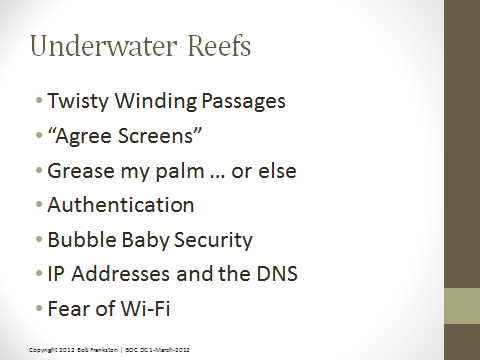
“Underwater reefs” is a Russian term for “bug”. In this context they refer to the impediments lurking beneath the surface of “The Internet” which impede connectivity.
The current complexity of passing through carrier passages which may or may not be billable makes it difficult to innovate since there is no relationship between the application and the way we fund it. How would you know that the reason your pacemaker isn’t communicating is that your landlord forgot to pay the cable bill?
A milder form is in the “agree” screens which lurk beneath the surface. If I’m going through the JetBlue terminal at JFK I can get free Wi-Fi but I cannot receive a phone call without T-Mobile coverage because I won’t even know there is a place to click “agree” unless I just happen to open a browser – assuming the device has a browser!
These problems are real but it is hard to get any effective improvement as long as we are still struggling just to get through today’s telecommunications infrastructure. We need to shift away from an approach in which bits are “billed or killed”. In today’s world any failure will leave us disconnected. We need to shift to a mode in which connectivity is the default.
We can benefit from understanding the history of toll roads in the United States. Until the 1920’s we had toll roads but, I argue, with the advent of the automobile it become too difficult to force cars past toll booths as alternative paths made it too easy to bypass the tolls. Instead of walling in the roads we recognized the importance of the roads as community facilities and funded them as such.
DIY Beyond the Internet
The talk focused on the Internet arising from DIY. The reverse is also true – the Internet is a platform that supports DIY. The process is iterative and multidimensional.
The relationships between the end points are interesting in and of themselves apart from any exchange of bits. For example if we have a medical device it has to be connected to the system that can monitor it. Exchanging bits is only one part of defining and managing the relationship. Even if both ends of the relationship are on the same computer we still have the challenge of relating the information.
The first step is to get the DIY process unstuck so we can get to the next steps.
Further Reading
You can read more at my site. The writings are at http://rmf.vc/Public. You can replace “public” with a keyword pointing to relevant writings including:
- Purpose vs. Discovery. Inverting the layered approach to innovation.
- Maker Disconnect. The “maker” or DIY object movement is thriving but it hits a wall when we try to build meta or connected devices.
- Ambient Connectivity. A reframing of the Internet by emphasizing availability everywhere without barriers.
- Thinking Outside the Pipe. Thinking beyond the limits of networks.
- The Internet as DIY. An essay I wrote preparing for this talk.







